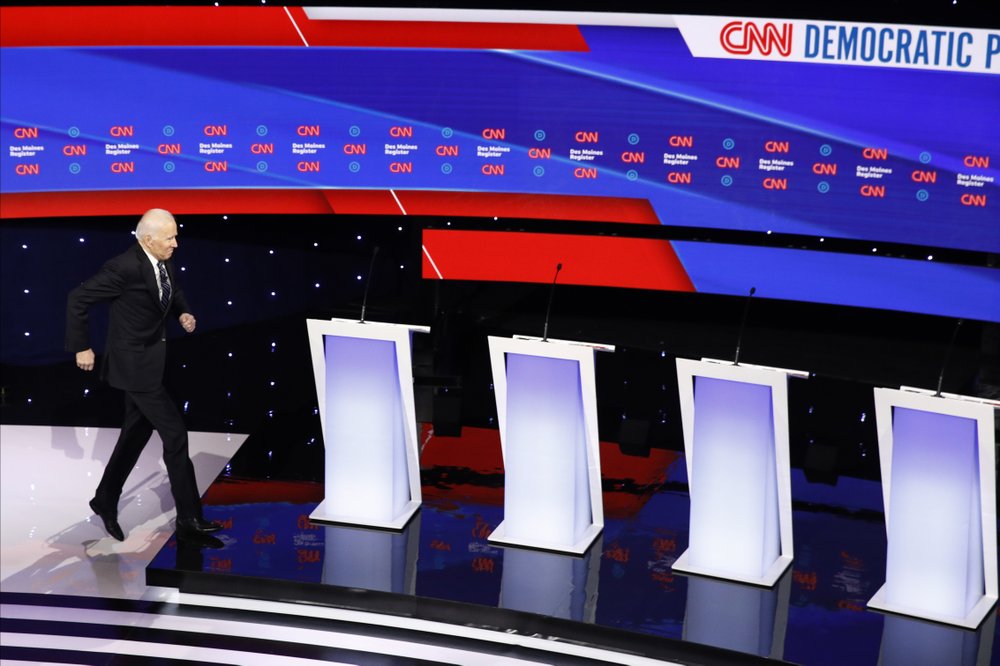It seemed easy to write off Joe Biden.
The former vice president came across as easily blindsided at debates. The crowds at his presidential campaign speeches were far from stadium size. Other Democratic candidates such as Bernie Sanders, Elizabeth Warren and Pete Buttigieg each had moments of radiating a kinetic energy, while Biden appeared to be conserving his resources.
But Biden had name recognition.
He is able to connect on an emotional level with people who have experienced personal loss, as he has. And as Barack Obama’s wingman for eight years, Biden was a reminder to many Democrats of what a president should be.
The opening contests in the 2020 nominating race in Iowa, New Hampshire and Nevada were humbling losses for Biden. Then came a commanding victory in South Carolina with help from African American voters. Rivals departed the race, and within days his coalition expanded to make him a lock for the nomination that was officially secured Friday night.
This is how Biden won.
It’s an account drawn directly from more than 40,000 people from AP VoteCast surveys in 17 states that voted between Feb. 3 and March 17. The result is a rich portrait of a diverse Democratic electorate eager to oust President Donald Trump. The issues confronting the nation intensified since Biden took an overwhelming lead in the primary as the United States now faces a pandemic, a recession and civil unrest due to racial inequality.
MODERATE VOTERS
A majority of Democratic voters wanted to put a moderate with practical policy proposals in office over a liberal with bold ideas. This should not be a surprise, given that 58% say they are moderate or conservative. At the same time, the surveys show a slim majority (53%) of voters say they prefer a dramatic overhaul of Washington, compared with 45% who want a return to a pre-Trump era.
Voters who wanted to restore the political system went for Biden over any other candidate, whether they wanted a liberal or a centrist. Sanders, a Vermont senator who is a self-described democratic socialist, had an advantage over Biden among those who wanted fundamental change and a liberal candidate. But even among those who support a sweeping transformation and centrist policies, 38% backed Biden.
___
OLDER VOTERS
A solid 61% of primary voters were older than 45 — a group that firmly supported Biden. His advantages among this group offset his weakness with younger voters. The demographic composition of Democratic voters was a barrier for Sanders. Voters under 30 were a key component of Sanders’ coalition but made up just 15% of the electorate. The pattern is similar among self-described liberals and people who saw themselves as falling behind in the economy.
___
IOWA AND NEW HAMPSHIRE WERE FALSE INDICATORS
The opening contests failed to set the tone for the rest of the country. Biden finished fourth in the Iowa caucuses on Feb. 3 and fifth in the New Hampshire primary about a week later. While those states got the bulk of attention from candidates, the results failed to sway voters elsewhere. Iowa and New Hampshire were whiter and much more supportive of sweeping change than the states that followed on the election calendar.
More important, the moderate vote was fractured in those places.
Before South Carolina, no candidate had earned more than one-third of this group. In New Hampshire, for example, about 6 in 10 voters identified as moderate or conservative. Roughly 3 in 10 went for Buttigieg, the former mayor of South Bend, Indiana. About one-quarter backed Minnesota Sen. Amy Klobuchar. Only about 1 in 10 supported Biden. By contrast, Sanders enjoyed a relatively clear advantage among liberals, with Massachusetts Sen. Warren well behind vying for those votes.
___
SALVATION IN SOUTH CAROLINA
South Carolina’s Feb. 29 primary gave Biden a much needed comeback. It was the first heavily African American state to have a say, and 64% of African American voters supported Biden. The state’s voters were more enthused about restoring the Obama era compared with voters in Iowa and New Hampshire. About 7 in 10 considered themselves to be moderate or conservative. More than half were nonwhite, unlike the roughly 9 in 10 white voters in Iowa and New Hampshire.
The delegate count was high enough in South Carolina that it shook up the field. Within 72 hours, Buttigieg, Klobuchar and billionaire Tom Steyer decided to set aside their presidential ambitions, clearing the way for Biden to build out his coalition.
___
LATE DECIDERS
Biden cemented his status a few days later during the Super Tuesday primaries on March 3. He won 10 states, including Texas, Massachusetts, North Carolina and Virginia. One key: voters making their choice in the few days before the elections, in what turned out to be a reflection of the momentum coming out of South Carolina. Across eight of the states with presidential primaries that day, 37% of voters said they made up their minds in the last few days. About half of them went to Biden.
Biden expanded his coalition among liberals, college graduates and even younger voters. Electability was at the forefront of many voters’ minds. In Minnesota, a potential November battleground, 60% of voters said it would be harder for a nominee with strong liberal views to win in the general election.
___
ALL BEFORE CORONAVIRUS AND GEORGE FLOYD’S DEATH
Throughout the primaries, Democratic voters said health care was the most important problem facing the nation. Climate change trailed in second place. The economy ranked a distant third. This made sense in the moment as the U.S. was coasting through the longest expansion in its history and the unemployment rate was at a half-century low of 3.5%.
But less than two weeks after the Super Tuesday primaries, everything changed.
The coronavirus pandemic has caused the unemployment rate to rocket to 13.3%, something not seen since the Great Depression. A survey in May from The Associated Press-NORC Center for Public Affairs Research found nearly 70% of the workers who lost their jobs expected to be rehired, compared with close to 80% just a month before, as the grim realities of restaurant closures and shuttered businesses become clearer.
Then there was another turn in May after the death of George Floyd in Minneapolis, which has sparked protests across the country for racial equality. Civil rights now has joined the economy as a dominant national issue.
During the primary, race relations fell behind health care, the economy and climate change as the most important issues for South Carolina Democrats, according to VoteCast. But voters trusted Biden most on racial matters, with a plurality, 39%, saying he would be the best Democrat to address that issue.
After months of campaigning from his basement, Biden emerged this past week to give a speech in Philadelphia.
“We can’t leave this moment thinking we can once again turn away and do nothing,” he said. “The moment has come for our nation to deal with systemic racism. To deal with the growing economic inequality in our nation.”
(AP)












2 Responses
Our wonderful progressive New York City mayor accused African American voters in South Carolina and the Super Tuesday primaries who voted for Biden of being low information voters.
Yup, racist.
AP stands for “Always Pessimistic” about trump